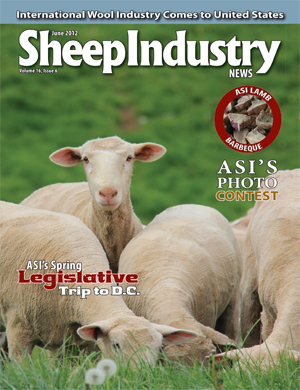International Wool Industry Comes to U.S.
(June 1, 2012) The 81st annual International Wool Textile Organization Congress (IWTO), themed WOOL IN THE CITY, commenced on May 7 in New York City. The conference was hosted by the American Wool Council, a divison of the American Sheep Industry Association (ASI), with 249 attendees from 23 countries and provided a forum for all segments of the wool industry to discuss trends and new opportunities. Attendees participated in sessions that focused on both technical advancements in wool processing as well as changes in marketing and product positioning.
The congress is the annual meeting point for the entire wool industry including growers, traders, primary processors, spinners and weavers. ASI is the head of delegation to IWTO for the United States.
“All of the U.S. major wool customers, domestic and intenational, were in attendance at this event,” says Rita Kourlis Samuelson, ASI director of wool marketing, adding that the congress provided an avenue to highlight the U.S. wool industry to potential buyers and build confidence in the U.S. wool industry.
Wool is natural, renewable and biodegradble. But, more work will be done to further demonstate wool’s sustainability. Sustainbility was a major buzz word throughout the congress and many of the sessions focused on this topic. Both brands and retailers, including consumers, are becoming more cogniziant of wool’s carbon footprint and the industry has been under pressure to provide research of wool’s enviromental impact. To help provide information, one initiative that came out of last year’s congress in China is for IWTO to provide an accurate life cycle analysis for wool.
The Sustainability Committee reported on its progress over the past year in this effort. They found a great deal of life cycle assessments for wool; however, only a few portraying the assessment from cradle to grave. The committee’s recommendation for the next year is to consolidate the numerous assessments and address the research gaps, specifically addressing on-farm research, determining how long wool products last and what happens to them at the end of their life cycle. In addition, the committee would like to develop a communications plan to provide the industry’s environmental credentials to the trade, brands and consumers.
The major action item that came out of the Grower Committee was for each country to develop a common guideline for all wool-producing countries for animal welfare issues, which the committee hopes to have finished by November.
This year’s congress also brought in the fashion and retail portion of the wool industry and provided the audience with insights into future market opportunities and an understanding of the U.S. market situation. Participants learned how the lines of communication have started to blur between consumer and design professionals with the use of social media and that the design world is hungry to hear about wool’s story regarding sustainability and its organic appeal.
Samuelson says she is pleased with the U.S. wool-apparel companies’ participation in the congress in addition to the other segments of the industry, stating, “The industry is so passionate about wool. Wool is truly a natural, high-performance fiber with a richness that improves over time. The congress served to inspire an industry representing a fiber that is positioned to be rediscovered for its many attributes including breathability, fire resistance, easy care and comfort.”
Peter Ackroyd, president of IWTO, concluded the congress saying, “It was pleasing to hear so many upbeat and optimistic presentations about the return of wool in floor coverings, furnishings and fashion. Several keynote speakers at the congress underlined the absolute necessity to embrace social media and networking to pass on wool’s unrivalled message to younger consumers.”


